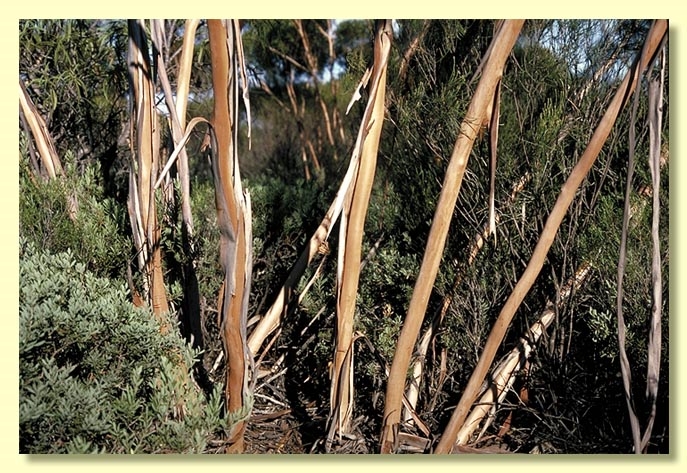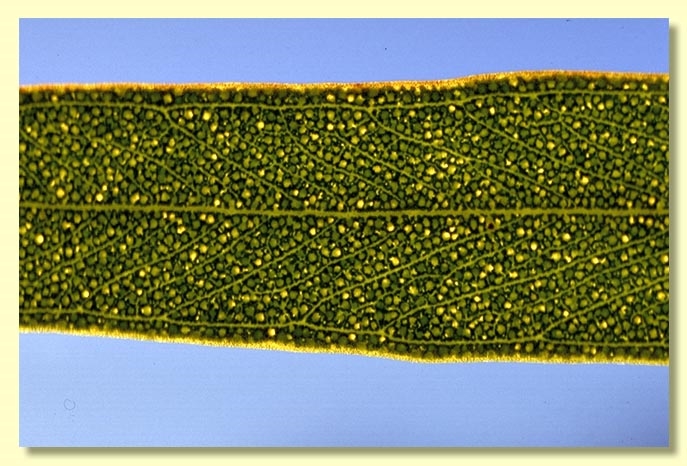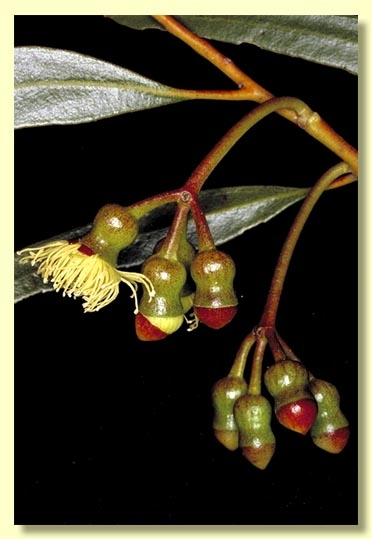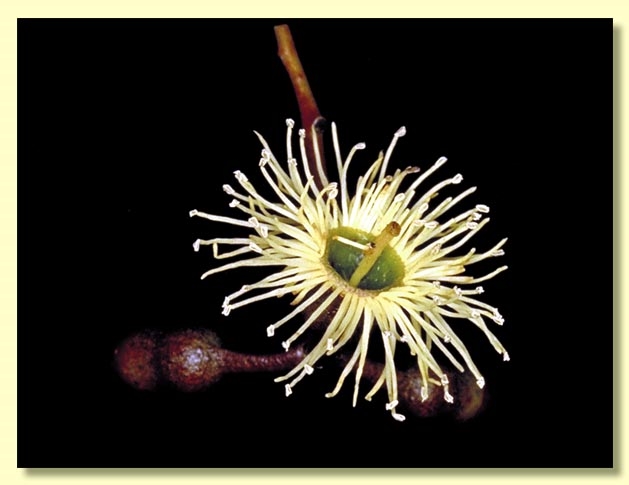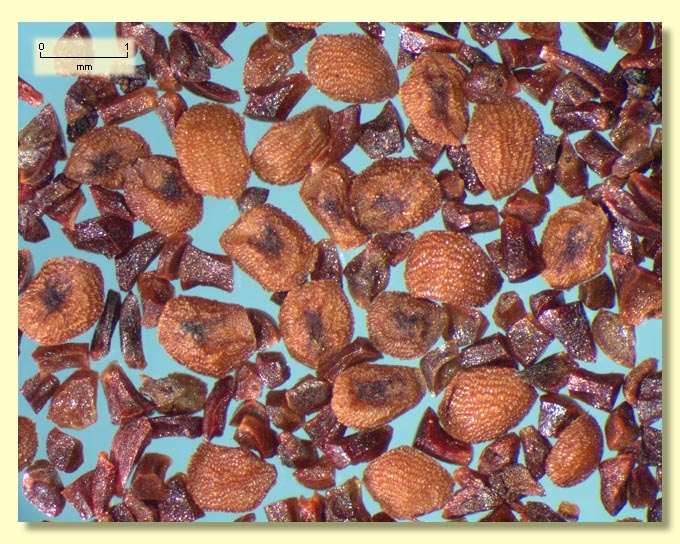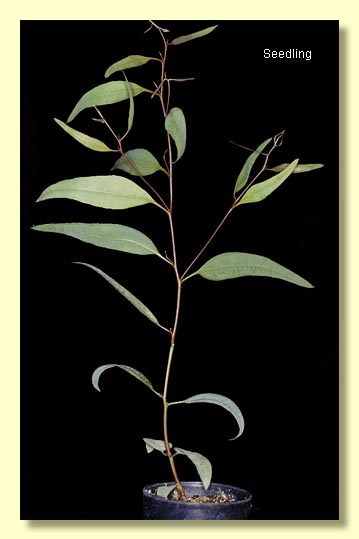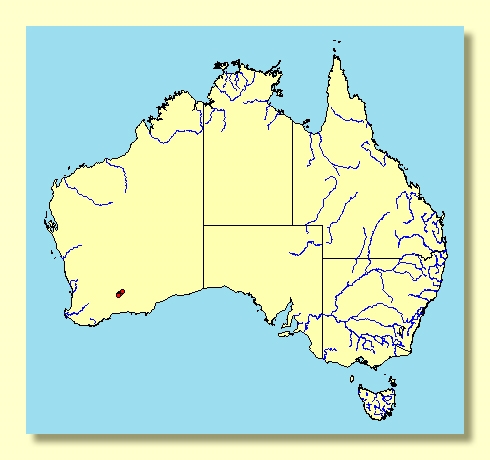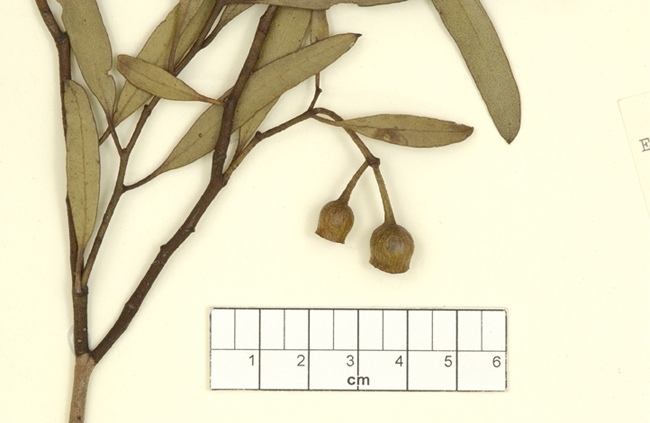Euclid - Online edition
Eucalyptus cerasiformis
Eucalyptus | Symphyomyrtus | Bisectae | Glandulosae | Elongatae
Bark pale grey and white mottled, sometimes powdery.
Branchlets with oil glands in the pith.
Juvenile growth (coppice or field seedlings to 50 cm): not seen.
Adult leaves alternate, petioles 0.8–2 cm long; blade lanceolate to narrowly so, 5–11.2 cm long, 0.5–1.5 cm wide, base tapering to petiole, margin entire or subcrenulate, apex pointed, concolorous, glossy, green, side-veins usually acute, reticulation sparse or obscure, intramarginal vein present, oil glands numerous, large.
Inflorescence axillary unbranched, pendulous, peduncles slender, 1.8–5 cm long, buds 7 per umbel, long-pedicellate (pedicels 0.7–1.6 cm long). Mature buds more or less cylindrical (0.9–1.1 cm long, 0.5–0.6 cm wide) with a narrow waist below the join of hypanthium and operculum, scar present (outer operculum shed early), inner operculum conical to rounded and apiculate, a few outer stamens erect, most stamens variably deflexed to fully inflexed, anthers oblong, versatile, dorsifixed, dehiscing by longitudinal slits, style long and straight, stigma blunt, locules 4 or 5, the placentae each with 6 or 8 vertical rows of ovules. Flowers pale yellow or whitish.
Fruit down-turned, pedicellate (pedicels 0.9–1.5 cm long), urn-shaped to campanulate, 0.8–1 cm long, 0.6–1.1 cm wide, disc descending, valves 4 or 5, enclosed, small.
Seeds brown, 0.5–1.5 mm long, ovoid to flattened-ovoid, dorsal surface shallowly reticulate, hilum ventral.
Cultivated seedlings (measured at node 10): cotyledons Y-shaped (bisected); stems rounded in cross-section; leaves always petiolate, opposite for 3 to 5 nodes then alternate, lanceolate, 9.5–11.5 cm long, 1.5–3 cm wide, green, more or less glossy.
Flowering has been recorded in October.
A small mallee endemic to Western Australia, known only from between Hyden and Norseman, north of the Johnston Lakes. It has smooth bark and glossy green leaves. Buds are pendulous and occur usually in sevens.
Eucalyptus cerasiformis belongs in Eucalyptus subgenus Symphyomyrtus section Bisectae subsection Glandulosae because the buds have an operculum scar, cotyledons are bisected and branchlets have oil glands in the pith. Within this large subsection (ca 80 species) E. cerasiformis is closely related to a group of mallees or mallets (series Elongatae) recognised by the glossy green leaf surface, leaves with many oil glands obscuring the reticulation but not the main side-veins, buds with very long conspicuous pedicels, short opercula, inflexed stamens and ovules in six or eight vertical rows. There are five species in series Elongatae — E. cylindriflora, E. cerasiformis, E. dielsii, E. armillata and E. erythronema (with 2 subspecies) .
E. cerasiformis is unlikely to be confused with any other species because of its restricted distribution, pendulous clusters of long-pedicellate blunt buds that are slightly narrowed in the middle and small urn-shaped to campanulate fruit. E. cylindriflora has cylindrical buds and fruit in erect clusters, E. dielsii is a mallet with pendulous clusters of blunt ovoid buds and fruit with a "brim" like a small bowler hat. E. erythronema has pendulous clusters of much larger buds in threes (rarely sevens), obconical fruit and glazed, olive-green leaves.
Eucalyptus cerasiformis is listed as "Vulnerable" under the Australian Government Environment Protection and Biodiversity Conservation Act 1999 (EPBC Act). Further information may be found at this web address:
http://www.environment.gov.au/cgi-bin/sprat/public/sprat.pl


